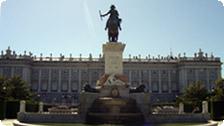by Jayme H. Simões
A shawl, a guitar, a voice and sincere emotion. These are the ingredients of Fado, the celebrated form of world music that captures what it is to be Portuguese.
Fado is the song that harnesses the Portuguese soul. Summed up by the Portuguese word saudade, the Fado can be about deep-seated feelings, a sense of sadness and longing for someone who has gone away, disappointments in love, everyday events, and the ups and downs of life. Inspiration for Fado can come from almost any source.
Nowadays, Fado is a celebrated form of world music that has retained its traditional qualities but moved with the times. Amália is the world-renowned singer who brought Fado to the great concert halls of Europe and to the attention of international audiences. For all Portuguese—and others too—Amália Rodrigues remains the great lady of Fado, the reference point for all time. The singer died in October 1999, but she remains a living symbol of this style of singing. Today, Fadista Mariza, who continues to tour overseas, takes the Fado to an even wider audience.
The more popular forms of Fado are heard in the cities near the sea, such as Lisbon or Porto. However Coimbra has given the music its own unique feel, making it popular among students. The intimacy of a restaurant or Fado house is still the best way to enjoy this music. A candlelit dinner, accompanied by songs you’ll understand even without speaking the language, is an experience that you simply have to include in your holiday plans.
The Fado and Its Origins
The word Fado comes from the Latin fatum, which means fate or destiny. Although no one knows exactly where the origins of Fado lie, Portugal’s traditional music remains at the very heart of the country’s culture still to this day. The Fado may have its roots in the 10th century songs of the troubadours, or the homesickness of seafarers, or even the Lundum songs sung by the black slaves from Brazil. What began with with popular rhythms and lyrics in Porto and Lisbon, gradually evolved into something more complex as the country developed as well. During the dictatorship period, Fado became one of the few cultural manifestations of this country. Even today the famous trilogy Fado, Fátima and Football (personified by Amália, Nossa Senhora de Fátima and Eusébio) is a heritage of those times
The first written record of Fado dates from the 19th century. Since that time the image of the music has been shaped by those who have sung it. Maria Severa, very much a Fado singer from her own local neighborhood, made this type of song famous in aristocratic circles through her romance with the Count of Vimioso.
Amália Rodrigues was both the voice and soul of poems written by Portuguese writers and helped to make Fado famous outside Portugal. Mariza is the most recent revelation and has continued the tradition of these earlier singers while also providing a new form for the singing of Fado.
Visit the Museu do Fado e da Guitarra Portuguesa to find our more about this music and then absorb the atmosphere of one of the Fado Houses at night. Visitors are able to learn more about the history of Fado through the use of audiovisual media and the museum’s extremely valuable store of documents, photographs, films, theatrical props, instruments and sundry objects. The museum also has a documentation center, an auditorium, a specialist shop and a cafeteria.
Largo do Chafariz de Dentro, Nº 1 | 1100-139 Lisboa | Tel. 218 823 470 | Fax. 218 823 478
museudofado@egeac.pt | www.egeac.pt
Voices of the Fado
Traditionally accompanied by the guitar, there are many ways of singing the Fado. It can range from the faster Fado corrido of Mouraria to the impromptu singing known as desgarrada, or the mournful music of the students of Coimbra. The most respected names are those of Amália Rodrigues, Maria da Fé, Hermínia Silva and Argentina Santos, whilst Carlos do Carmo is one of the best-known male voices, famous for the way he sings about Lisbon.
A new generation of Fado singers have brought listeners new fresh voices, such as Dulce Pontes, who was featured in the Hollywood film “Primal Fear” with Richard Gere, and Mariza, who won the BBC Radio Award for World Music in 2003. Other new names in Fado are Mísia, Camané, Mafalda Arnauth and Katia Guerreiro. They all have an emotional commitment to their singing.
If you want to sample some of this traditional music, the Grand Night of Fado is the place to go. Held every year in Lisbon and Porto, it’s a very special evening that showcases the best new musical talents and helps to launch careers and discover unique voices.
The Coimbra Fado
“Coimbra is more enchanting when it’s time to bid farewell.” This is the most famous line from this city’s Fado. It sums up the romantic spirit of the university students who sing it. The Fado of Coimbra bears a close instrumental resemblance to the Fado that is sung in Lisbon, however its lyrics have become more erudite and displays a different spatial quality, with a different type of vocal effect.
The Fado of Coimbra was developed by university students who arrived from Lisbon and Porto and brought with them their guitars and a different way of singing. They found Fado the ideal vehicle for preserving the memories of student life. They sing about unrequited love, sleepless nights, or serenading their sweethearts from under the window. Dressed in their traditional academic costume of black suits and thick gowns, it is only the males in the student population who sing the Fado. The best time for listening to them is Queima das Fitas, the traditional festival held in May to mark the end of the academic year. There is also great local emotion during the Noite da Serenata when serenades are sung outside the entrance of the city’s old cathedral.
Lisbon & the Fado
In Lisbon, the nights begin with Fado. An accompaniment to the city’s history, Fado grew out of the old quarters of Mouraria, Alfama, Bairro Alto and Madragoa. With themes of fate and conflict, noblemen, vagrants and seafarers alike shared this traditional music, often sung in a way that displayed intense suffering.
Fado can also have a lighter side and describing love affairs, conquests, and the different life experiences of each neighborhood. The artist José Malhoa immortalized these moments in his famous paintings of the Fado.
The music’s fame gradually built up in the Fado houses, where only those with a professional license could sing. Amália was the most charismatic of these early Fado singers and the first to take the music overseas. Possessing a great stage presence and being a natural entertainer, Amália left us with the classical image of the traditional Fado singer in a black dress and shawl. Her former home is now a museum and is well worth the visit.
Where to see Fado in Lisbon
A Baiuca, a tiny, fun-loving restaurant in the heart of the Alfama district, serves up spirited Fado with traditional home-cooking. The menu and wine list is straightforward, but the pre-dinner munchies are costly—turn them away. The English-speaking manager, Henrique, also welcomes Fado enthusiasts who just want a drink. This intimate place truly is a neighborhood affair, with grandma dancing with a bottle on her head and the cooks gazing out of their steamy hole in the wall to catch the musical action. Everyone seems to get into the music.
€12-25 meals, Fado Thu-Mon 20:00-24:00; just off Rua São Pedro up the hill from House of Fado, at Rua de São Miguel 20, tel. 218-867-284). Information obtained at www.ricksteves.com
Meals include Entradas (bread, butter, olives, cheese), soup, main course (meat/veal chop or fish/cod fish), desert and drinks (wine, water or juice – excludes alcohol)
Tasca do Chico
No meal is required but visitors can snack on tradicional petiscos, such as Chouriço Assado (a grilled Portuguese sausage for 5 Euros) or a Bifana (a pig steak sandwich for 1,75 Euros.) For drinks, visitors can have a small glass of Sangria or wine (1Euro) or Ginja/Port/Moscatel for 2,5 Euros. The singers perform Fado Vadio, amateur Fado, and perform from 10 pm until 2am on Mondays and Wednesdays.
Rua Diário de Notícias, Nº 39 1200-141 Lisboa
Tel. +351 96 505 9670 (Mr. Francisco Goncalves)
For more suggestions also visit the official website of the Lisbon Tourism Office




